We’ve all faced that frustrating challenge of wanting beautiful container gardens in shady spots around our homes. Whether it’s a north-facing porch dim corner of the yard or that cozy nook under a sprawling tree these areas often feel impossible to decorate with vibrant plants.
But what if we told you that shade doesn’t have to mean boring? The secret lies in choosing the right shade-loving plants and creating stunning planter combinations that’ll transform those forgotten spaces into lush green sanctuaries. From colorful foliage plants to delicate flowering varieties there’s an entire industry of shade plants just waiting to brighten up your containers.
We’re here to share our favorite shade planter ideas that’ll help you create eye-catching displays in even the darkest corners of your outdoor space. These container combinations aren’t just practical – they’re absolutely gorgeous and surprisingly easy to maintain.
Choose the Right Containers for Shade Gardens
Selecting appropriate containers sets the foundation for successful shade garden planters that’ll thrive in low light conditions.
Size and Drainage Considerations
Large containers work best for shade gardens because they retain moisture longer and provide ample root space for multiple plant varieties. We recommend choosing planters that are at least 12 inches deep and 16 inches wide for optimal plant health. Deeper containers allow roots to establish properly while wider bases prevent toppling during windy conditions.
Drainage holes are absolutely essential for preventing root rot in shade environments where soil takes longer to dry. We drill additional holes if containers don’t have enough natural drainage points. Position containers slightly elevated on pot feet or bricks to improve airflow underneath.
Multiple drainage layers enhance water management in shaded locations where evaporation rates are naturally slower. We add a 2 inch layer of gravel or broken pottery at the bottom before adding potting soil. This technique prevents waterlogged conditions that can kill even the most resilient shade plants.
Material Options for Shaded Areas
Fiberglass planters resist moisture damage better than other materials in consistently shaded environments. These lightweight containers won’t crack from freeze thaw cycles and maintain their appearance for years without fading. We prefer fiberglass for permanent shade garden installations.
Ceramic and glazed pottery containers add elegance to shaded spaces while providing excellent insulation for plant roots. Natural clay breathes well but may crack in winter temperatures. We choose glazed versions for year round durability in shade gardens.
Resin and plastic containers offer budget friendly options that perform well in low light conditions. Modern versions mimic natural materials convincingly while weighing significantly less than stone or ceramic alternatives. We select UV resistant varieties to prevent brittleness over time.
Style Matching for Your Outdoor Space
Contemporary containers complement modern home architecture with clean lines and neutral colors that won’t compete with shade plants. We choose rectangular planters in charcoal or white finishes for sleek patio designs. Geometric shapes create visual interest without overwhelming delicate foliage.
Traditional urns and decorative pots enhance classic garden styles particularly when placed near formal entryways or structured landscapes. We select containers with subtle textures or raised patterns that add sophistication to shade planting schemes. Aged finishes blend naturally with established garden environments.
Rustic containers suit cottage gardens and informal outdoor spaces where weathered appearances feel authentic and welcoming. We use galvanized metal tubs wooden barrels and vintage inspired planters for casual shade garden displays. Natural materials develop beautiful patina over time in shaded conditions.
Select the Best Shade-Loving Plants for Containers
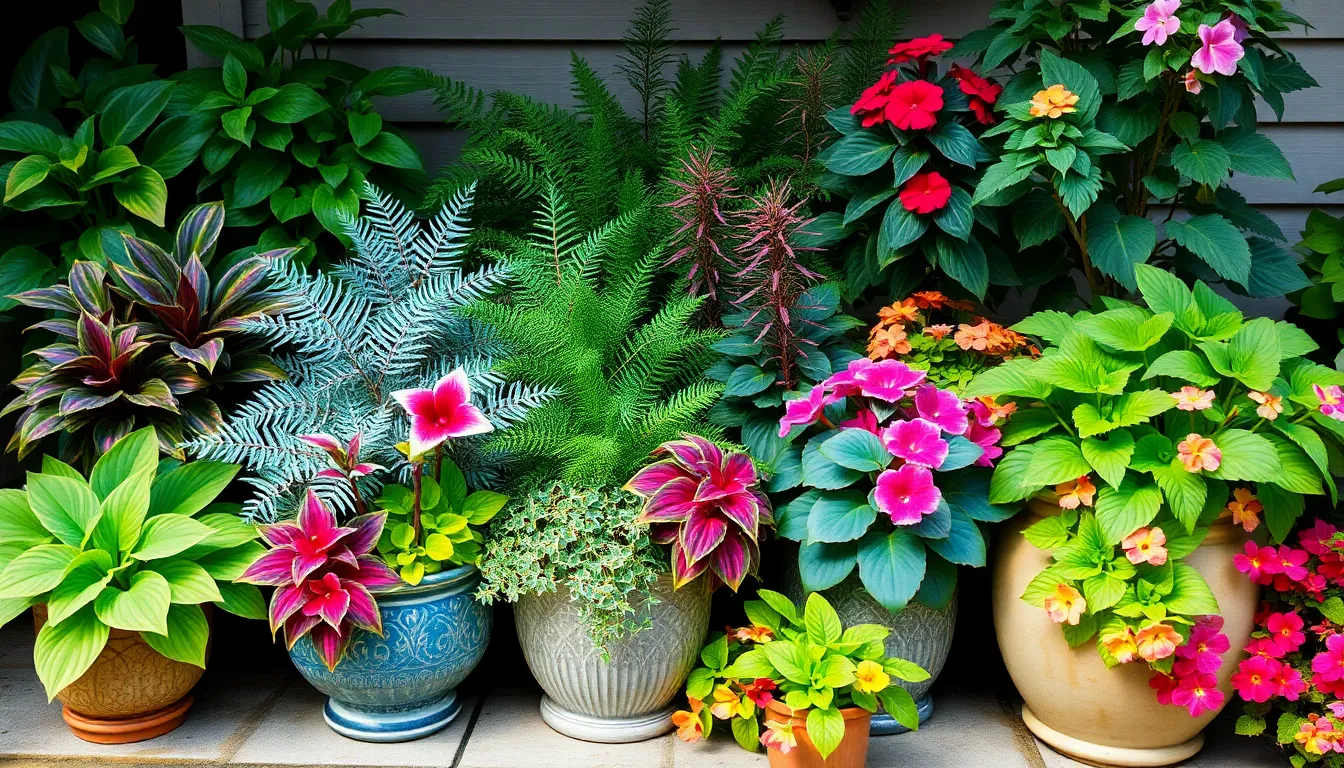
Now that you’ve chosen the perfect containers, let’s explore the plants that’ll transform your shady spaces into thriving garden displays. We’ve tested countless varieties and discovered which shade lovers truly excel in container environments.
Foliage Plants That Thrive in Low Light
Hostas provide lush greenery and adapt beautifully to container life, offering dozens of size options from miniature to large specimens. We recommend starting with medium varieties like ‘Sum and Substance’ or ‘Patriot’ for dramatic impact in your shade planters.
Ferns create instant jungle vibes and excel in shaded containers, particularly Japanese painted fern, maidenhair fern, wood fern, and lady fern. Dryopteris wallichiana adds especially dramatic texture with its bold fronds that cascade elegantly over container edges.
Ornamental sedges (Carex) bring movement and fine texture to shade arrangements, with golden or variegated varieties providing striking contrast against darker foliage. These grasses sway gently in breezes and maintain their beauty throughout multiple seasons.
Coleus brightens shade areas with vibrant foliage in colors ranging from deep burgundy to lime green, making it our go to choice for adding instant color impact. Brunnera offers silvery leaves paired with delicate blue flowers, while false shamrock (Oxalis triangularis) contributes rich purple foliage that unfolds like tiny umbrellas.
Flowering Varieties for Shaded Planters
Impatiens deliver continuous blooms throughout the growing season and thrive in partial to full shade conditions, making them perfect for beginners. We particularly love the New Guinea varieties for their larger flowers and more robust growth habit.
Begonias offer long lasting flowers in shades of pink, red, white, and coral, with many varieties tolerating full shade while still producing abundant blooms. Wax begonias work especially well in containers because they’re compact and self cleaning.
Astilbes create feathery plumes of flowers in early to mid summer, adding vertical interest and soft texture to shade container combinations. Pansies and violas provide cheerful faces in cool weather, with compact growth habits perfect for container edges.
Brunnera produces delicate blue spring flowers that complement its heart shaped foliage, while some trailing varieties cascade beautifully from hanging baskets or tall containers. These flowering plants work together to create season long color in your shaded spaces.
Edible Plants Perfect for Shade Containers
Leafy greens thrive in shaded containers and actually prefer cooler conditions, making lettuce, chard, kale, spinach, and pak choi excellent choices for productive shade gardens. We’ve found these vegetables often taste better when grown in partial shade because they’re less likely to bolt in hot weather.
Broccoli tolerates some shade and produces compact heads perfect for container growing, especially when you choose varieties bred for small spaces. Swiss chard adds both nutrition and beauty with its colorful stems in red, yellow, and orange.
Shade loving herbs provide fragrant, edible leaves while requiring minimal maintenance in container environments. Chives, parsley, and cilantro all perform well in partial shade and can be harvested continuously throughout the growing season.
These edible plants grow best when kept consistently moist but well drained, making proper container drainage even more critical for successful harvests. You’ll enjoy fresh salads and herbs while creating beautiful, productive displays in your shaded outdoor spaces.
Create Stunning Color Combinations in Shade Planters
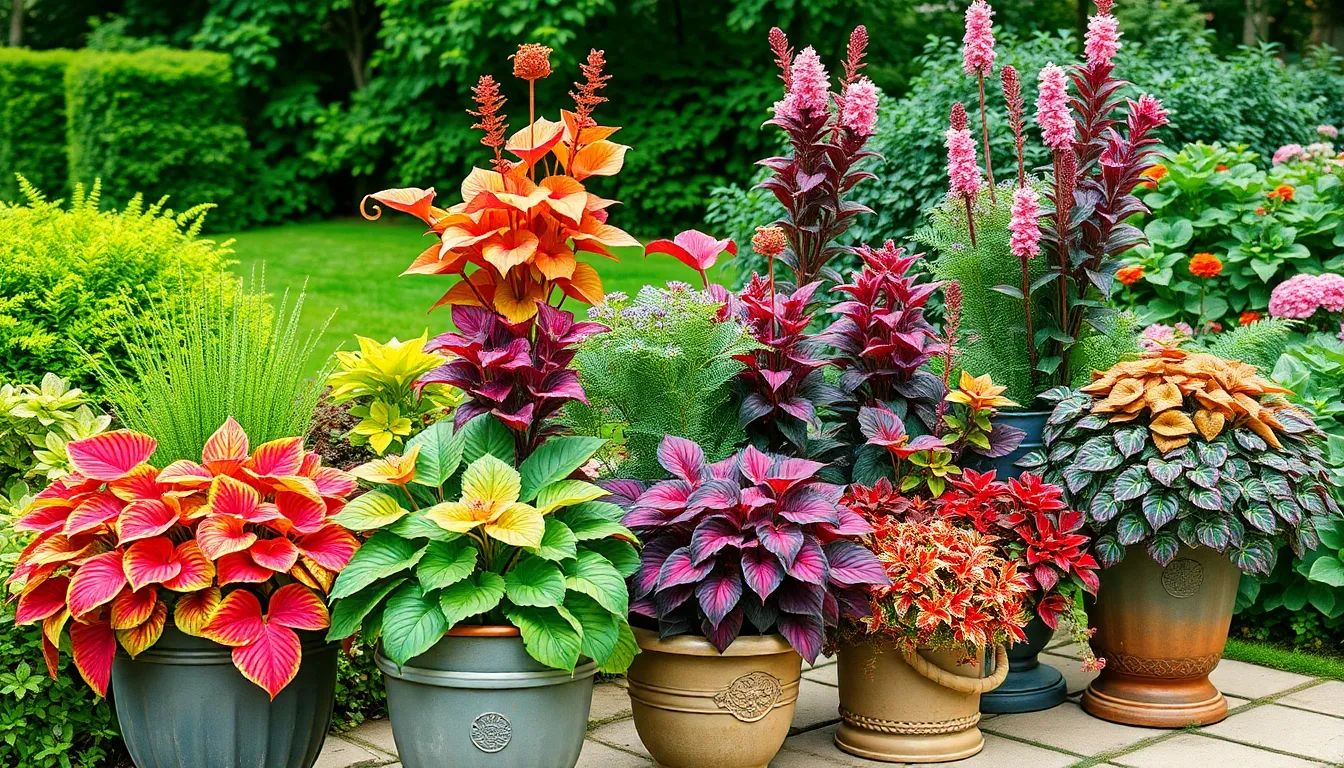
Now that we’ve covered plant selection, let’s explore how to combine these shade-loving plants into visually striking color arrangements. Brightly colored or shiny metal containers paired with lighter foliage and flowers can transform even the darkest corners into vibrant focal points.
Monochromatic Schemes for Elegant Appeal
Monochromatic planting schemes create sophisticated displays by focusing on a single color family with varying shades and textures. We recommend starting with a red-toned container featuring Begonia ‘Exotica’ with its olive-green and deep-pink leaves as your centerpiece. Blood leaf (Iresine lindenii) adds depth with its deep-maroon foliage, while Caladium bicolor ‘Rosalie’ brings dramatic contrast with red-centered leaves edged in green.
Balance becomes crucial when working within one color palette. Adding lacecap hydrangea with white-edged leaves provides textural contrast that prevents the scheme from feeling overwhelming. This approach allows the monochromatic design to feel ever-changing while maintaining its elegant, cohesive appearance.
Varying saturation levels within your chosen color keeps the display interesting. Light pink begonias paired with deeper burgundy coleus and coral-toned caladiums create natural gradation that draws the eye through the entire container arrangement.
Contrasting Textures and Heights
Combining plants with different leaf textures adds immediate visual depth to shade containers. Large, bold caladium leaves create stunning contrast when paired with fine-textured ferns or the delicate foliage of lacecap hydrangeas. Variegated plants brighten shadowy areas naturally, while plants with thin or metallic-sheen leaves add sophisticated contrast.
Vertical elements prevent the flat appearance common in shade plantings. Trailing sweet potato vine cascading over container edges works beautifully with upright Japanese maple or bamboo positioned as focal points. This height variation reduces the leggy appearance that shade conditions often cause in container plants.
Leaf shape diversity creates natural structure within your planters. Broad hosta leaves provide excellent backdrop for spiky ornamental sedges, while rounded begonia foliage contrasts beautifully with the feathery texture of astilbe plumes.
Seasonal Color Rotation Strategies
Rotating plants seasonally keeps shade planters vibrant throughout the year. We layer reliable foliage plants like coleus, Japanese painted fern, Rex begonias, and sweet potato vine as your foundation for long-lasting color. These base plants provide consistent appeal for multiple months without requiring frequent replacement.
Flowering annuals add seasonal punch to your established foliage foundation. Impatiens, fuchsias, begonias ‘Bonfire’, and Torenia (wishbone flower) bloom in diverse colors from blue to yellow and thrive in shade conditions. These plants can be swapped out seasonally to refresh your color themes without replanting entire containers.
Strategic plant positioning allows easy seasonal updates. Place your permanent foliage plants in the center and back of containers, then use smaller pots within the main container for seasonal bloomers. This technique lets you adjust color themes with seasonal changes while maintaining your core planting structure.
Design Multi-Level Planter Arrangements
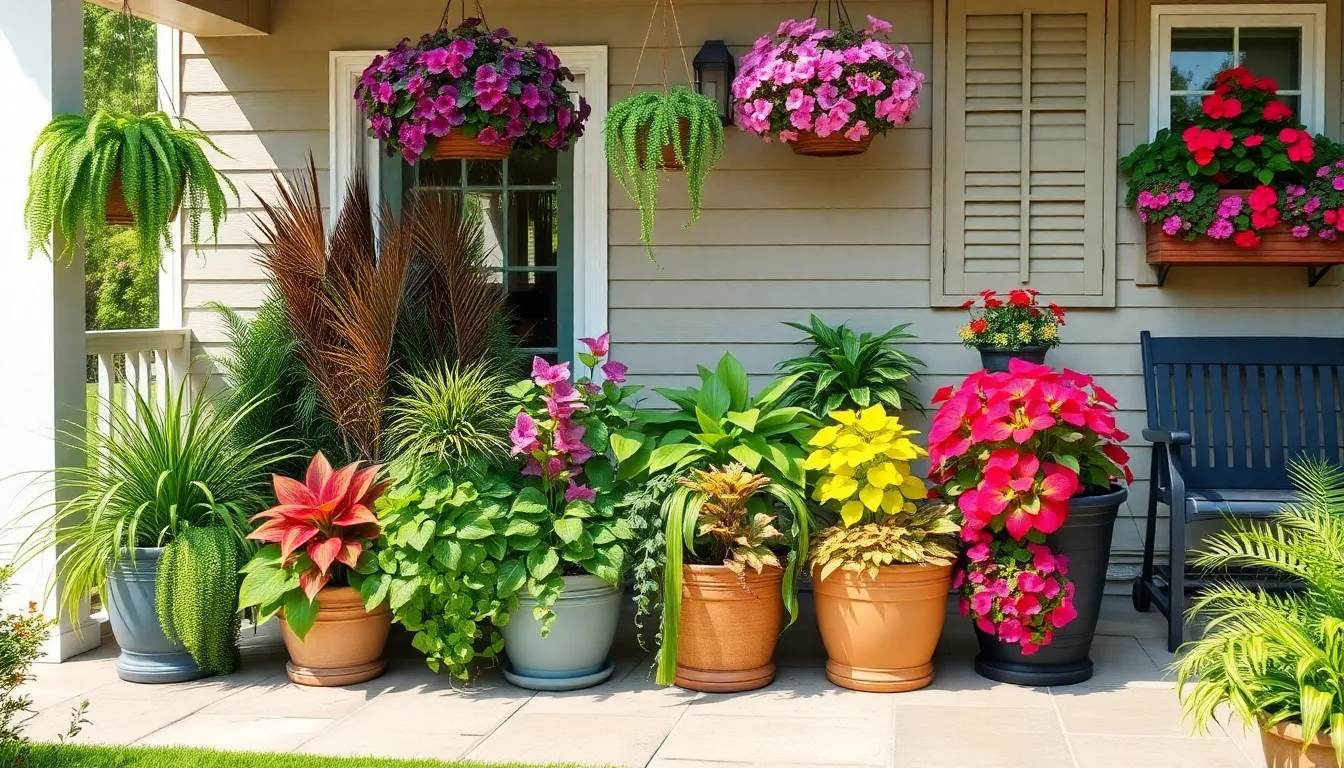
Building on our color and texture strategies, we’ll explore how vertical layering creates stunning shade garden displays that maximize both space and visual impact.
Tiered Container Groupings
Stackable planter stands transform small shaded areas into impressive vertical gardens that showcase multiple plant varieties. We recommend starting with large pots at the bottom tier for tall shade plants like ornamental grasses or small shrubs that create a strong foundation. Medium containers work perfectly for the middle level, where we can feature ferns, impatiens, or colorful coleus that bridge the height gap beautifully.
Finishing touches come from small containers at the top tier, where trailing plants like ivy or spider plants create elegant spillover effects. Plant stands and risers provide the structural support needed for these arrangements while ensuring each plant receives adequate light and air circulation. Tiered containers also allow us to group plants with similar water requirements, making maintenance much more manageable in shaded environments.
Hanging Basket Integration
Suspended planters add a floating garden effect that brings greenery to eye level and above in shaded spaces. We love using hanging baskets filled with shade tolerant plants like Boston ferns, trailing impatiens, and cascading spider plants that create natural curtains of foliage. Tree branches, pergola beams, and specialized hanging hooks provide perfect mounting points for these aerial displays.
Trailing varieties that spill over basket edges add movement and softness to rigid architectural elements around patios and porches. These elevated planters also help us use vertical space without cluttering ground areas, making them ideal for narrow walkways or compact shaded zones where floor space is limited.
Window Box and Rail Planter Combinations
Window boxes and railing planters create cohesive layered looks when combined strategically around shaded outdoor living areas. We fill these containers with shade friendly annuals like begonias, caladiums, and fuchsias that offer both bold foliage and delicate blooms throughout the growing season. These planters frame architectural features beautifully while providing cascading greenery that softens hard edges.
Coordinating these horizontal planters with our vertical arrangements creates seamless transitions between different garden levels. Rail planters work especially well for deck railings and balcony edges, where they can trail downward to connect with lower planted areas and create unified garden compositions in challenging shaded spaces.
Maintain Proper Soil and Watering for Shade Plants
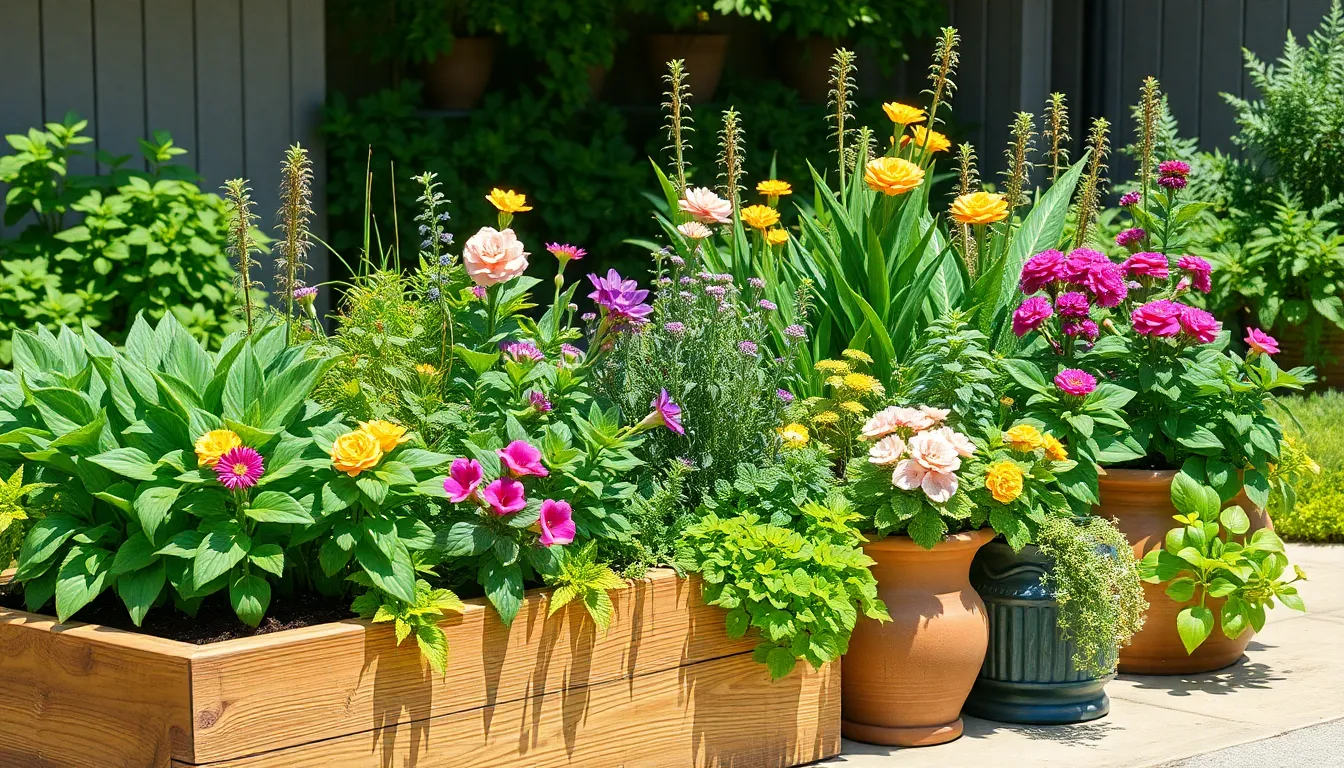
Success with shade container gardens depends on getting the fundamentals right. Proper soil preparation and watering techniques create the foundation for thriving plants that receive less than six hours of sunlight daily.
Soil Mix Requirements for Container Gardens
Select a high-quality potting soil designed specifically for container gardening to give your shade plants the best start. We recommend choosing mixes that incorporate organic matter and perlite for enhanced porosity and drainage. Adding perlite to your soil blend improves aeration and moisture retention, which becomes crucial since containers dry out faster than in-ground plantings.
Mix slow-release fertilizer into the top several inches of soil before planting your shade containers. This approach provides steady nutrients over time without overwhelming your plants. Fresh soil ensures your plants receive adequate nutrition from day one.
Replace or replenish your container soil annually to maintain optimal nutrient levels and soil health. Over time, soil breaks down and loses its structure, making annual refreshing essential for continued plant success.
Watering Schedules for Low-Light Conditions
Water your shade containers when the top inch of soil feels dry rather than following a strict schedule. Shade plants don’t require as frequent watering as sun-loving varieties, but they still need consistent moisture to thrive. Checking soil moisture with your finger provides the most reliable indicator of watering needs.
During hot weather, you may need to water once or twice daily to prevent your containers from drying out completely. Heat increases evaporation rates even in shaded areas, making more frequent watering necessary. Early morning or late afternoon watering reduces evaporation and minimizes plant stress.
Avoid overwatering your shade plants since they use water more slowly than plants in full sun. Shaded conditions reduce both evaporation and plant water usage, making excess moisture a common problem that can lead to root rot.
Fertilization Needs in Shaded Environments
Incorporate time-release fertilizer at planting to supply your shade plants with gradual nutrition throughout the growing season. This slow, steady approach works perfectly for the reduced metabolic rates typical of shade plants. The consistent nutrient supply eliminates the guesswork from feeding schedules.
Supplement with water-soluble fertilizer every two weeks during the active growing season, especially during midsummer when nutrients may leach from frequent watering. This additional feeding keeps your plants healthy and promotes steady growth. Focus particularly on mid-season feeding when nutrient depletion becomes most noticeable.
Feed your containers at least once per year, though heavy-feeding plants may require more frequent applications. After fertilizing, flush your containers with water to prevent harmful salt buildup that can damage plant roots. Proper flushing maintains soil health and prevents nutrient burn.
Position Your Shade Planters for Optimal Growth
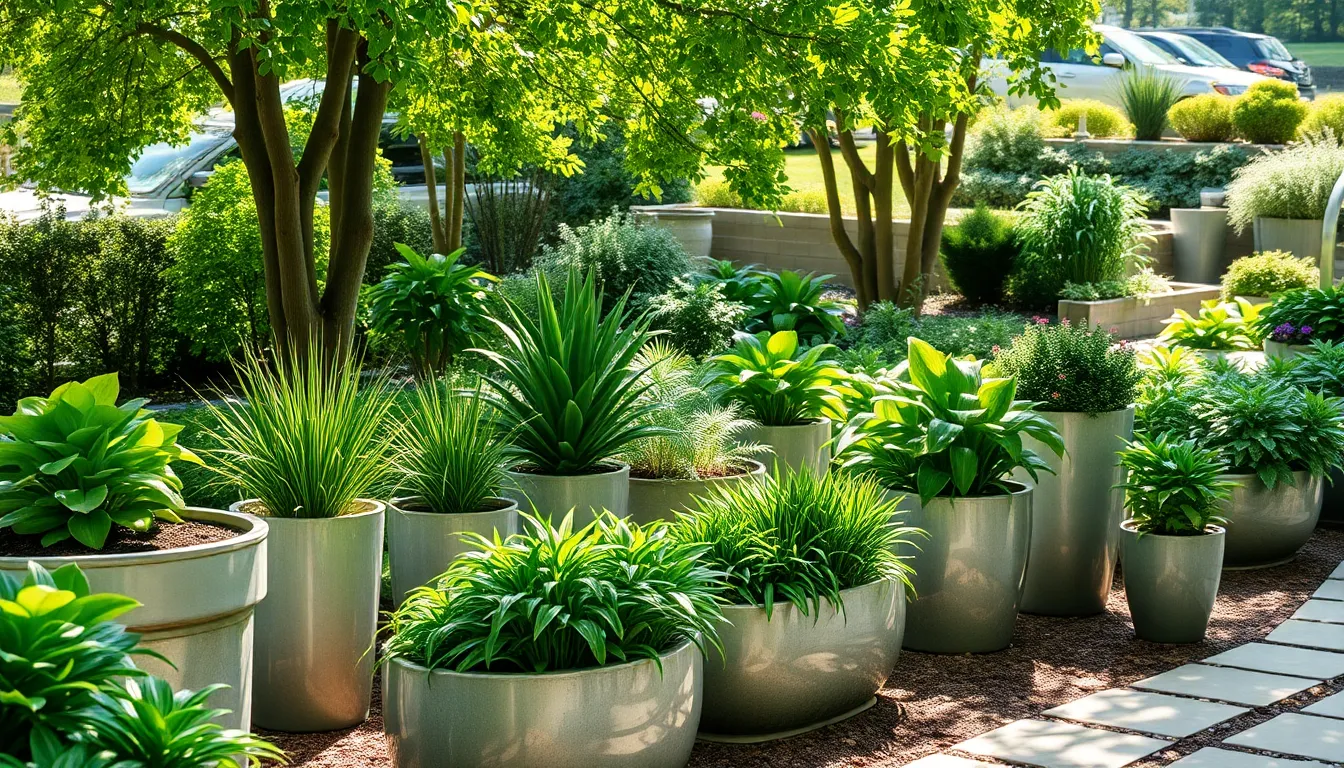
Finding the perfect spot for your shade containers requires understanding your garden’s unique light patterns and environmental conditions. Strategic placement ensures your shade loving plants receive optimal growing conditions while protecting them from harsh elements.
Understanding Different Shade Types
Full shade areas receive less than 3 hours of direct sunlight daily and avoid intense afternoon sun exposure. These locations typically occur under dense tree canopies, on north facing sides of buildings, or in corners where structures block most sunlight throughout the day.
Partial shade conditions allow some direct morning sunlight but provide protection from strong afternoon rays. We often find these spots under high branching trees, areas with filtered light through pergolas, or spaces that receive morning sun but afternoon shade from nearby structures.
Dappled shade creates moving light patterns as sunlight filters through tree leaves or lattice work. This ever-changing lighting condition works well for containers since plants receive varying amounts of light throughout the day, making it suitable for a wider range of shade tolerant varieties.
Maximizing Available Light Sources
Reflective containers help amplify available light in darker corners by using brightly colored or shiny metal planters. We recommend silver, white, or light colored containers that bounce existing light back onto plant foliage, creating brighter growing conditions without moving the planters.
Strategic positioning places containers where they can capture maximum available light while remaining in shade zones. Position planters near light colored walls, under skylights, or close to areas where reflected light from sunny spots can reach your shade plants.
Light colored mulch spreads across container soil surfaces to reflect upward light onto plant leaves. Materials like white gravel, light colored bark chips, or pale stone mulch create additional illumination while helping retain soil moisture in shade conditions.
Plant combinations using contrasting foliage colors create visual brightness that makes shaded areas appear more luminous. Pair dark green hostas with silvery heuchera, or combine chartreuse coleus with deep purple caladiums to maximize color impact in low light areas.
Protection from Wind and Weather
Sheltered locations protect delicate shade plants from strong winds that can damage tender foliage or quickly dry out container soil. We position planters near walls, under overhangs, or behind larger plants that act as natural windbreaks while maintaining shade conditions.
Sturdy container materials withstand weather fluctuations better than lightweight options in exposed shade areas. Choose durable materials like fiberglass, concrete, or heavy ceramic planters that resist tipping in wind while providing stability for root systems.
Drainage considerations become especially important in sheltered shade areas where air circulation may be limited. Ensure containers have adequate drainage holes and use elevated pot feet to prevent water from pooling around container bases during heavy rains.
Microclimate monitoring helps us understand how wind patterns and temperature fluctuations affect our exact shade planting areas. Check for cold drafts in winter, hot air pockets in summer, or areas where wind funnels between structures to select appropriate plant varieties and container placement.
Solve Common Shade Container Gardening Problems
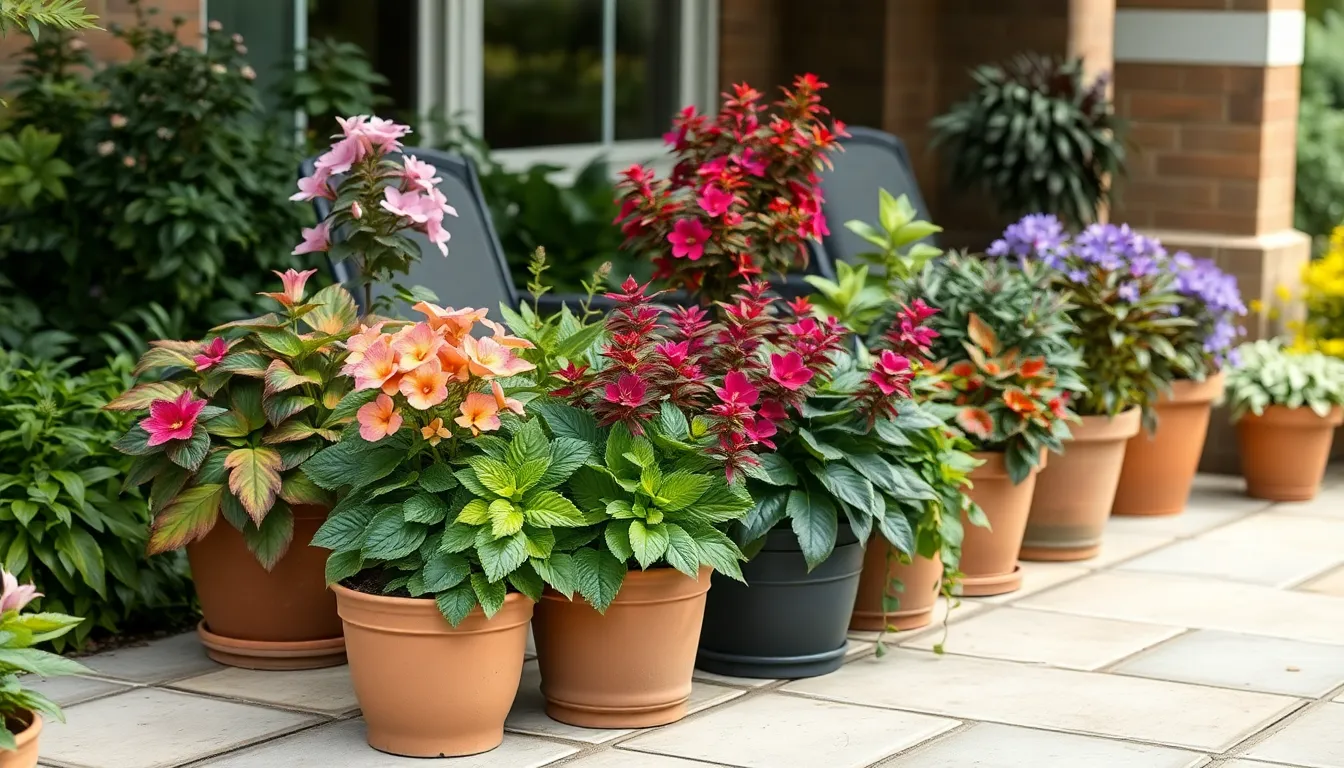
While shade gardens offer unique beauty and tranquility, they also present exact challenges that require thoughtful answers. We’ve identified the most common issues gardeners face and developed proven strategies to overcome them.
Preventing Root Rot in Moist Conditions
Root rot poses the greatest threat to shade container plants since these environments naturally retain moisture longer than sunny locations. We recommend using high-quality, well-draining potting soil specifically designed for containers to prevent waterlogging. Always choose containers with ample drainage holes to allow excess water to escape freely.
Water only when the top inch of soil feels dry to the touch, avoiding the temptation to overwater during cooler shade conditions. Elevate containers slightly using pot feet or blocks to improve drainage and increase airflow around the base. This simple step prevents water from pooling beneath containers and reduces humidity that contributes to root rot development.
Monitor soil moisture levels regularly since shade plants dry out more slowly than their sun-loving counterparts. Replace or refresh container soil annually to maintain proper drainage properties and prevent compaction that traps excess moisture around roots.
Dealing with Pest Issues in Shade Gardens
Shade environments create ideal breeding conditions for pests like slugs and fungus gnats due to increased dampness and reduced air circulation. We suggest conducting regular plant inspections to catch pest problems early before they establish large populations. Remove affected foliage immediately to prevent pest spread and eliminate breeding sites.
Deploy natural predators such as beneficial nematodes for soil-dwelling pests or introduce ladybugs for aphid control. Organic insecticides provide effective treatment options when natural methods aren’t sufficient to manage serious infestations.
Reduce excessive watering practices that create breeding grounds for moisture-loving pests like fungus gnats. Improve air circulation around containers by spacing them appropriately and removing dense vegetation that blocks airflow. Apply diatomaceous earth around container bases to create natural barriers against crawling pests like slugs and snails.
Addressing Leggy Growth in Low Light
Low light conditions often cause plants to stretch toward available light sources, resulting in weak, leggy growth that compromises plant appearance and health. We recommend selecting shade-tolerant species that naturally maintain compact, bushy growth habits rather than fighting against plant biology.
Supplement natural light with artificial grow lights positioned 12-18 inches above plants to provide additional photosynthesis energy. LED grow lights work particularly well for shade containers since they produce minimal heat while delivering full spectrum lighting.
Prune leggy stems regularly to encourage fuller growth and prevent plants from becoming weak and spindly. Pinch growing tips on young plants to promote branching and create denser foliage. Add colorful foliage plants with naturally compact forms to distract from any sparse growth while the main plants fill out.
Rotate containers periodically to ensure all sides receive equal light exposure and prevent one-sided stretching toward light sources.
Conclusion
We’ve shown you that shaded areas don’t have to be gardening dead zones. With the right combination of containers plants and thoughtful design strategies your shadowy spaces can become the most captivating areas of your outdoor living space.
The beauty of shade container gardening lies in its flexibility and low-maintenance nature. Once you’ve established your foundation plants and mastered the watering techniques these gardens practically care for themselves while delivering consistent visual impact.
Remember that successful shade gardening is about working with your environment rather than against it. By understanding your exact light conditions and choosing plants that truly thrive in those settings you’ll create displays that look effortless and natural.
Start small with one or two containers and gradually build your shade garden as you gain confidence. We’re confident that once you see how these plantings transform your space you’ll be planning your next shade container project.
Frequently Asked Questions
What size containers work best for shade container gardens?
Choose containers that are at least 12 inches deep and 16 inches wide. Large containers are ideal because they retain moisture better and provide ample root space for shade plants. Ensure your containers have proper drainage holes to prevent root rot, which is especially important in shaded areas where soil takes longer to dry.
Which plants are best for shady container gardens?
Excellent shade-loving plants include foliage plants like hostas, ferns, and ornamental sedges. For color, try impatiens, begonias, and astilbes. You can also grow edible plants like lettuce, kale, chives, and parsley in shade containers. These plants thrive in cooler, low-light conditions and add both beauty and functionality.
How often should I water shade container plants?
Check soil moisture regularly rather than following a strict schedule. Shade plants need less frequent watering than sun plants, but they still require consistent moisture. Stick your finger into the soil – if it’s dry an inch down, it’s time to water. Proper drainage is crucial to prevent waterlogged soil.
What type of soil is best for shade containers?
Use high-quality potting soil specifically designed for containers. Mix in organic matter and perlite for improved drainage and aeration. Add slow-release fertilizer to the soil mix for sustained nutrition. Replace or replenish container soil annually to maintain proper nutrient levels and soil structure.
How can I create colorful shade container arrangements?
Use monochromatic color schemes for elegant appeal, or try bright containers with lighter foliage and flowers. Balance colors by varying saturation levels and combine different textures and plant heights. Create layers with trailing and upright plants, and rotate seasonal flowering annuals while maintaining a foundation of reliable foliage plants.
What are the different types of shade for container gardening?
The three main types are full shade (less than 3 hours of direct sunlight), partial shade (3-6 hours of morning or filtered sunlight), and dappled shade (filtered light through tree canopies). Understanding your specific shade type helps you select appropriate plants and optimize container placement for better growth.
How do I prevent common problems in shade container gardens?
Prevent root rot with well-draining soil and proper drainage holes. Combat pests through regular inspections and improved air circulation. Address leggy growth by choosing compact plant varieties, using artificial grow lights if needed, and rotating containers for even light exposure. Monitor soil moisture carefully to avoid overwatering.
Can I grow edible plants in shade containers?
Yes! Many edible plants thrive in shade containers, including leafy greens like lettuce, spinach, and kale. Herbs such as chives, parsley, cilantro, and mint also do well in cooler, shaded conditions. These plants provide fresh produce while beautifying your shaded spaces, making them both practical and attractive additions.







